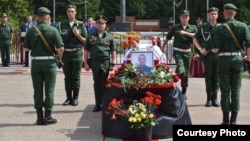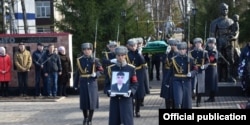More soldiers from the central Russian regions of Tatarstan and Bashkortostan have died than any other region in the country, according to a confirmed tally of war deaths compiled by RFE/RL's Tatar-Bashkir Service, with a further sharp increase recorded in recent weeks.
The tally, corroborated in part by a separate count by the BBC Russian Service and Mediazona, is the latest indication of how the burden of the Kremlin's war on Ukraine is disproportionately falling on more distant regions of Russia, further away from the wealthy population centers of Moscow and St. Petersburg.
The reason for the recent increase is unclear, but it comes two years after President Vladimir Putin stunned the country by announcing a "partial" mobilization that called up some 300,000 men to fight.
Overall, Russian casualties -- killed or wounded in action -- are believed to exceed 500,000 according to Western estimates, with more men killed over the past 30 months than in an entire decade of the Soviet invasion of Afghanistan in the 1980s.
That burden has fallen heavily on regions where members of other ethnic groups outnumber ethnic Russians, such as Bashkortostan and Tatarstan.
"Tatarstan and Bashkortostan are not poor regions," said Dmitry Treshchanin, editor of the Russian-language Mediazona website, which together with the BBC Russian Service is independently compiling tallies of Russian casualties.
"Tatarstan, in particular, is the envy of many other regions. It cannot be said that people in these two republics volunteer to fight because of a lack of resources or money," he told RFE/RL. "In my opinion, there is a lot of administrative pressure, and people are being sent there 'voluntarily-compulsorily.'"
The situation with casualties from the two regions seems "irrational," he said.
"At the beginning of the war, deaths from [the North Caucasus region of] Daghestan were conspicuous," Treshchanin said. "But now we see constantly Tatar and Bashkir names like Marat and Marsel."
Death On The Volga
The Russian government has been notoriously tightlipped about its war losses since it launched its full-scale invasion in February 2022. Its last official figure came in September 2022, with 5,937 Russian soldiers killed. At the time, the Ukrainian side was reporting Russian losses at nearly 10 times that figure.
That has made it difficult for reporters, analysts, and outside observers to gauge the full impact of the war on specific populations.
Still, from the beginning of the full-scale invasion, analysts have noted that nonethnic Russians have been disproportionately represented among the country's military casualties.
Bashkortostan, a mid-Volga republic with a population a little over 4 million, had 3,026 confirmed deaths as of September 26, according to RFE/RL's accounting, which used announcements on social media, obituaries, and other open sources to gather the data.
In Tatarstan, which has a similar population, RFE/RL registered 2,740 deaths from the region.*
A recent tally by BBC Russian/Mediazona, which used a similar methodology: listed 2,705 confirmed deaths in Bashkortostan and 2,259 in Tatarstan.
In addition to mobilized soldiers sent to fight in Ukraine, other populations include prison inmates and private military company mercenaries, as well as "kontraktniki"-- men who voluntarily sign contracts to fight, induced by extraordinarily high wages and veterans benefits, including for widows and survivors.
Among kontraktniki, Bashkortostan leads Russia in the number of confirmed deaths: 965, according to the RFE/RL tally. Tatarstan ranked second, with 557 volunteer deaths.
By comparison, only 135 volunteers from Moscow -- with an official population of more than 13 million -- have been confirmed as killed.
Over the last four weeks, RFE/RL's Tatar-Bashkir Service has added 575 names to its list of dead soldiers from the two regions, nearly 20 per day.
The confirmed figures are assumed to be a major undercount given the difficulty in identifying deaths amid official secrecy.
It's also unclear exactly how many men in total have been sent from Bashkortostan and Tatarstan to fight in Ukraine: kontraktniki, prison inmates, mobilized troops, or otherwise.
A Statistic Or A Tragedy?
Moscow is paying "special attention" to the Volga region, Tatar political analyst Ruslan Aysin said, as part of what he said was a deliberate Kremlin attempt to "confuse the political status" of the so-called ethnic republics, as the regions of Russia with large nonethnic-Russian populations are known.
Putin's government, he said, is trying to bolster support for the war -- or at least temper discontent -- among ethnic Russians in large cities like Moscow and St. Petersburg by minimizing their casualty burden.
For the authorities, each military death, Aysin said, is "just a statistic."
"But for the republic, for the ethnic group, for the individual family, this is a great tragedy," he said. "There is a big gap between the leadership and the average citizen.
In January, Bashkortostan saw a wave of nonviolent protests over the sentencing of Fail Alsynov, a popular activist longtime advocate for minority rights and the Bashkir language and culture, to four years in prison for purportedly stoking interethnic enmity.
The protests were fueled in part by simmering discontent about the costs of the Ukraine war for the region, analysts said.
'Most Of The Fatalities Now Are Volunteers'
On September 20, the BBC Russian/Mediazona project -- which tracks war deaths by monitoring funeral notices and other open-source data -- reported it had confirmed more than 70,000 killed soldiers nationwide.
In the early phases of the war, the average Russian war death was a contract soldier in his early 20s, the project noted. Now, however, typical deaths are volunteers in their 40s, 50s, and even 60s, "most often without military experience or specialized training."
The oldest reported casualty was a 71-year-old volunteer, according to the report.
Treshchanin said about 12.7 percent of all killed Russian soldiers were caught up in the September 2022 mobilization order. Officially, some 300,000 men were mobilized, but some analysts believe the figure was higher.
Overall, BBC Russian/Mediazona estimated the total number of casualties nationwide ranging from 107,000 to 155,000.
Western estimates are similar.
In May, then-French Foreign Minister Stephane Sejourne said that about 150,000 Russian soldiers had been killed. U.S. Defense Secretary Lloyd Austin said in June that at least 300,000 Russian soldiers had been killed or wounded, calling it "the price that Russia has paid for Putin's imperial ambitions."
Treshchanin said he and his colleagues have a backlog of about 4,000 names that they are trying to confirm.
But he said the main trend now involves volunteers, who have recently gone to fight.
"It is not a rare situation," Treshchanin said, "when a man who went off to war in July already has his obituary published in August."

















